► GMA’s new V12 convertible
► Weighs 18kg more than coupe, manual only
► Run of 100 almost sold out
Gordon Murray Automotive has unveiled its new T.33 Spider, an open-topped version of the T.33 coupe. Although it shares its powerplant, drivetrain and aerodynamic performance with its fixed-head sibling, this is not a simple roof-out conversion. The Spider features bespoke surfacing from the A-pillar back, increased luggage and storage space, and a focus on every-day driving versatility. No, really…
Is GMA getting a bit soft and chasing boulevardiers?
Certainly not. Work on the Spider started two years ago, and although it was developed in parallel with the coupe from the get-go, the Spider was the baseline for all Murray’s demanding dynamic benchmarks including torsional rigidity, ride and handling, agility and steering response. Which as you can guess, are pretty high benchmarks. Which is why the fixed rear roof section is an integral part of the carbon composite chassis, creating an incredibly stiff structure and providing rollover protection.
So it has the same underpinnings as the T.33 coupe?
Yes indeedy. It’s powered by the same mid-mounted 3994 cc Cosworth GMA.2 V12 engine as the fixed head T.33, and it’s unlikely we’ll see another road-going engine like it. Look at its specifications and it’s hard not to believe that there’s some serious witchcraft going on at Cosworth. The aluminium-alloy dry-sump unit weighs just 178kg, and is redlined at 11,100rpm – just 1000rpm lower than the version fitted to the T.50 fan-assist car. It develops 607bhp at a wailing 10,250rpm and 333lb ft of torque at 6,750rpm, with 300lb ft available from 4,500rpm to 10,500rpm. That’s a specific output 158bhp per litre, for a power-to-weight ratio of 548bhp per tonne. Compare that the power-to-weight-ratio of 543bhp per tonne for the original McLaren F1.
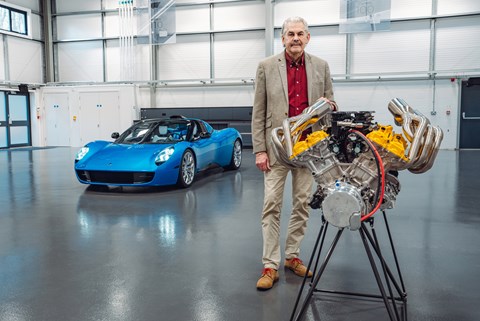
It inhales through the centrally-mounted ram induction intake that feeds four individual throttle bodies and 24 fuel injectors. Murray is keen to emphasise that open-top driving will be a hugely immersive experience. ‘It’s important to remember that it will be induction sound that will fill the Spider’s cabin, not the exhaust note, and induction is dependent on throttle opening, rather than engine speed.’ Which means a goosebumpy soundtrack under acceleration, but no continuous and tiring engine blare at constant speeds. Those banana-yellow cam covers are a hat-tip the Murray-designed Duckhams Ford LM race car piloted by Alain De Cadenet and Chris Craft at Le Mans in 1972, while the twin exhaust outlets are redolent of those on the Porsche 904.
Talk me through the brakes, suspension and steering, then
Brakes are the same as those on the coupe – 370mm discs gripped by six-piston monobloc calipers up front, and 340mm discs with four-piston monobloc calipers at the rear. All discs are 34mm thick carbon ceramic units for low unsprung mass and fade-free retardation. Suspension is aluminium double-wishbones with coilover dampers at each corner. No adaptive or selectable damping here.
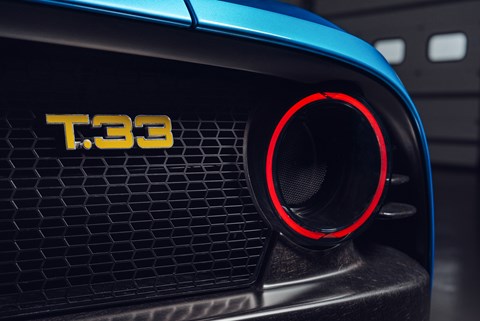
The electro-hydraulic steering combines a traditional hydraulic set-up for consistent feel and weight with an on-demand electric pump for assistance. As with the T.33 coupe, the rear wheels are driven through an Xtrac-supplied six-speed manual transmission that weighs in at just 82kg. GMA claims there’s no lighter supercar transmission. The limited slip differential – mechanical, rather than electronic – comes from specialists Salisbury. There’s no longer the option of a paddle-shift transmission. Murray was convinced that many buyers would demand one, and estimates GMA invested £3m in its development, only to find out no one wanted it. ‘Always happy to proven wrong by what GMA customers want,’ says Murray with a wry smile.
I presume the Spider is packed with F1-inspired tech?
Correct – the Spider mines the rich seam of Murray’s Formula 1 experience. The powertrain is an integral part of the chassis, with the rear aluminium double wishbones directly mounted to the casing of the six-speed manual gearbox. The powerplant uses GMA’s in-house Inclined Axis Shear Mounting system to filter out unwanted noise and vibration in the cabin.
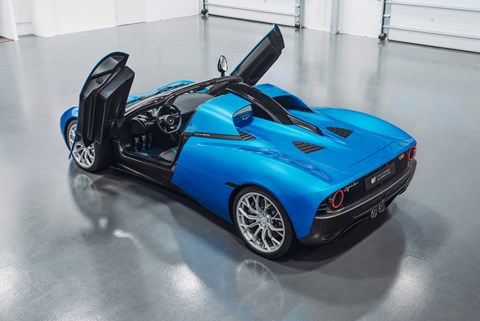
The Spider posts the same aerodynamic performance as the coupe with GMA’s Passive Boundary Layer Control that made its debut in the T.33 coupe recalibrated for the Spider. At the front, a ground-effect inlet funnels low pressure air beneath the floor and into a rear diffuser complete with a boundary layer removal duct. In conjunction with the deployable active rear spoiler – borrowed directly from the T.33 coupe – GMA claims the Spider has the optimal combination the low drag, high-downforce and high-speed stability, with or without the roof panels in place.
Exotic materials abound. The chassis uses GMA’s innovative iStream Ultralight carbon fibre monocoque technology, capitalising on its ability to strategically dial in the thickness of the lay-up where it was needed most. Aluminium alloy used for the engine’s block and heads, titanium for its conrods, and Inconel superalloy deployed for the exhaust manifolds.
So how do you go from roof-on to open-air driving?
Simple – remove the pair of carbon composite roof panels, drop the glass rear screen and you’re good to catch some rays. Once removed, the two carbon composite roof panels stow away in bespoke fabric cases in the nose, with Murray reckoning it should take owners a round a minute to go from closed coupe to open two-seater.
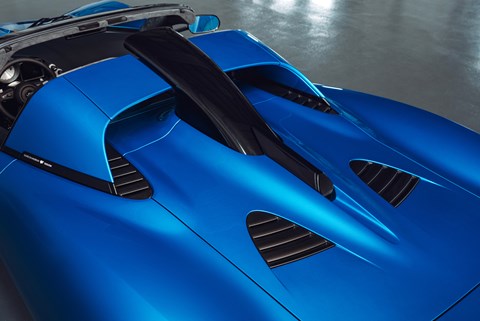
‘I didn’t want those twin bubbles behind the headrests because they’re always offset, so they look awful and they’re really not good for aero,’ he add explaining why he opted for the fixed rear roof section. ‘Designing the Spider from a clean sheet meant that we could get the aero just right, not just for dynamics, and minimising buffeting in the cabin but also for heat extraction,’ he says, pointing to the four vents (‘chimneys’ in Murray-speak) in the rear deck.
And the cabin architecture – the same as the T.33 coupe?
Well, if you spend thousands of hours nailing down the ergonomics, and create some insanely tactile machined controls and dials this side of a Sinn showroom, then why would you change things? Slip down into the one-piece composite seats, grip the delightfully thin-rimmed wheel – carbonfibre wrapped in leather – and every key control is a handspan from the wheel. Visibility is excellent, there’s plenty of room to move in all directions, and the intelligent simplicity of the controls thumbs its nose at every touchscreen-laden rival out there.
Explain how a 200mph supercar can be versatile
‘Day-to-day versatility in a supercar is a challenging concept,’ admits Murray, ‘but anything that we felt might prevent on owner from using the Spider every day was just thrown out.’ The level of detail that has gone into achieving this level of versatility is – no surprise here – impressive. Despite being just 18kg heavier than the coupe at 1108kg, the Spider has 295 litres of usable stowage space, 15 litres more than the coupe.
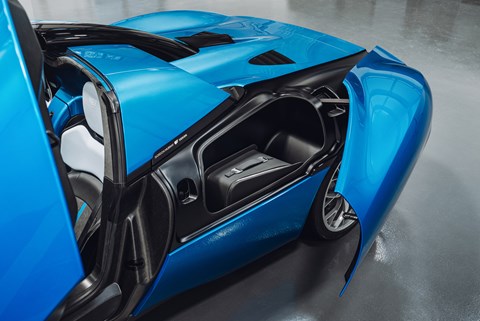
Rising to 90 degrees on a single hinge when open, the dihedral doors offer excellent access to remove the two carbon-composite roof panels. A concealed button under the doors opens up the articulated pannier covers in the Spider’s haunches to reveal a pair of unexpectedly deep 90-litre luggage compartments. The pannier covers open within the footprint of the open doors, and with both doors and covers open there’s a generous gap between them for drivers to access the panniers. The body-coloured spine that runs down between the seats – Murray’s nod to the Corvette C1 – opens up to hold water bottles, and there’s further oddment storage areas beneath and in front of the secondary control console. ‘That concept of versatility explains why the T.33 has a ride height that can deal with speed bumps without resorting to nose-lifting systems,’ says Murray. ‘It even extends to the choice of tyres because the Michelin Pilot Sport 4 S is readily available.’
Safe to assume that owners can have any paint and trim combo they want?
Yes, although GMA has pulled together four curated colour themes to guide owners through the endless maze of options: Return to Beauty – think rich blues and greens; Engineering Art – metallic silvers and technical greys; Murray Atholl tartan – brighter green, red and blue combos; and Tropical – to reflect Murray’s personal love of vibrant Hawaiian shirts.
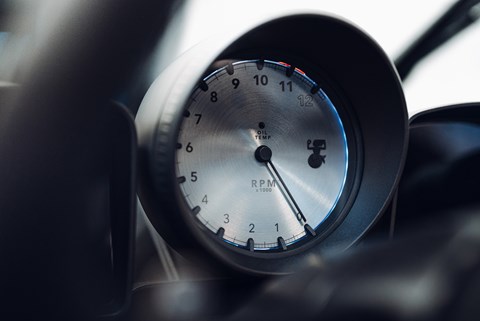
When can I buy one?
Now, but be quick because they’re selling fast. ‘We first contacted existing GMA customers, and in particular those that missed out on the T.50, T.50s and T.33 coupe and after that we very quickly filled the order books,’ says Murray. For a few enthusiastic customers, the T.33 Spider will give them a full set, joining the T.50, T.50s and T.33 coupe that are already in their climate conditioned garages. They’ll be hand-made at around three a week alongside the T.33 coupe at GMA’s new UK assembly facility at Windlesham in Surrey, with deliveries stating on mid-2025.
Anything else in the GMA pipeline?
Yes. Murray told us that he plans to produce 300 vehicles off the T.33 platform. With the T.33 coupe and T.33 Spider underway, the last member of the T.33 range will be a track-focused coupe. ‘It won’t be a track car, it will still be road legal, but it will be aimed at those drivers who enjoy taking their cars on track,’ explains Murray. Think an intelligent and comprehensive dynamic approach that combines less weight with sharper dynamics rather than simply more grunt. Best you make that call now.